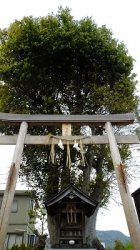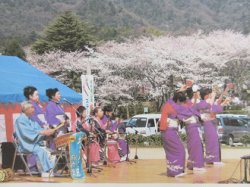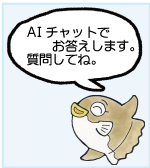境港市指定文化財の一覧(4)
21)日御碕神社の地引網絵馬( Jibikiami votive tablet of Hinomisaki Shrine)
■分類:民俗文化財(有形)
■指定年月日:平成23年9月1日
- <地引網絵図>
<まぐろ漁絵図>
昭和7年から11年にかけ、弓ヶ浜半島ではクロマグロが大漁だったといわれている。この絵図は、昭和10年、網主・松本貞造がマグロの大漁を祝って奉納した絵馬で、中野町出身の画家・景山栄治によって描かれたものである。漁師がマグロと格闘する姿が迫力を持って描かれており、地引網絵図と同様、後世に伝えていくべき貴重な作品といえる。
■公開状況:公開(日御碕神社への事前連絡が必要)
■所在地:小篠津町
■アクセス:JR中浜駅下車、徒歩5分
■ Classification: Tangible Cultural Property (Folk)
■ Designated Date: September 1, 2011
<Jibikiami picture>
From the Edo period to around 1965, seine fishing was popular on the Yumigahama Peninsula. This picture shows the state of seine net fishing around the end of the Edo period, and vividly depicts people who expect a big catch of nets that are fried when the rising sun rises. A votive tablet dedicated to a shrine by Aminaka of Go Nagami Net in 1897, the author is said to be a painter from Shinya-cho, Adachi Chimatsu, and you can learn about the lifestyle of the ancestors and the fishing methods at that time. It is a valuable material.
■ Designated Date: September 1, 2011
<Jibikiami picture>
From the Edo period to around 1965, seine fishing was popular on the Yumigahama Peninsula. This picture shows the state of seine net fishing around the end of the Edo period, and vividly depicts people who expect a big catch of nets that are fried when the rising sun rises. A votive tablet dedicated to a shrine by Aminaka of Go Nagami Net in 1897, the author is said to be a painter from Shinya-cho, Adachi Chimatsu, and you can learn about the lifestyle of the ancestors and the fishing methods at that time. It is a valuable material.
<Tuna fishing picture>
It is said that bluefin tuna was a big catch on the Yumigahama Peninsula from 1945 to 1945. This votive tablet was dedicated by the net owner, Sadazo Matsumoto, to celebrate the big catch of tuna in 1945, and was drawn by Eiji Kageyama, a painter from Nakano-cho. The figure of a fisherman fighting with tuna is powerfully depicted, and it can be said that it is a valuable work that should be passed down to posterity, like the seine net drawing.
It is said that bluefin tuna was a big catch on the Yumigahama Peninsula from 1945 to 1945. This votive tablet was dedicated by the net owner, Sadazo Matsumoto, to celebrate the big catch of tuna in 1945, and was drawn by Eiji Kageyama, a painter from Nakano-cho. The figure of a fisherman fighting with tuna is powerfully depicted, and it can be said that it is a valuable work that should be passed down to posterity, like the seine net drawing.
■ Public status: Public (requires prior contact with Hinomisaki Shrine)
■ Location: Koshinozucho
■ Access: Get off at JR Nakahama Station, 5 minutes walk
22)外江町の才の木(Tonoecho's Sai no Ki Tree)
■分類:民俗文化財(有形)
■指定年月日:平成23年9月1日
芝町から外江町へ向かう旧道沿いに「才の木」と呼ばれるエノキ・クスの巨木があり、傍らには「才の木神社」と称する小さな祠と鳥居が置かれている。由来は定かではないが、地元では「才の木さん」と呼ばれて親しまれている。
■指定年月日:平成23年9月1日
芝町から外江町へ向かう旧道沿いに「才の木」と呼ばれるエノキ・クスの巨木があり、傍らには「才の木神社」と称する小さな祠と鳥居が置かれている。由来は定かではないが、地元では「才の木さん」と呼ばれて親しまれている。
江戸時代、村の入口や分かれ道には、村や旅人を守る神として「サイノキ」「サイノカミ」「道祖神」と呼ばれる巨木や祠などが祭られていた。地域によって石像や木製の人形を祭るところもあったが、中でも、樹勢の強いエノキは、生命力が強いことから信仰の対象となることが多かった。信仰の起こりは定かではないが、松尾芭蕉が著した『奥の細道』(1702年刊)には、旅に誘う神として登場している。
また、村人にとって身近な存在であることから、病気平癒の神、縁結びの神などとしても親しまれてきた。外江町の才の木は耳病を治す神として知られ、地元を中心に熱心な信者を集めている。木の根元には、信者が願いを込めて吊るした椀が飾られており、信仰に託した人々の思いが伝わってくるようだ。以前、このような場所が市内各地にあったが、今ではここ1ヶ所を残すのみとなった。先人達の信仰や暮らしぶりを伝える貴重な場所として、これからも大切にしていきたいものである。
■公開状況:公開
■所在地:外江町
■アクセス:JR上道駅下車、徒歩20分
■公開状況:公開
■所在地:外江町
■アクセス:JR上道駅下車、徒歩20分
■ Classification: Tangible Cultural Property (Folk)
■ Designated Date: September 1, 2011
■ Designated Date: September 1, 2011
There is a giant camphor tree called "Sai no Ki" along the old road from Shiba-cho to Tonoe-cho. There is a small shrine and torii called "Saito no Ki Shrine". The origin is not clear, but it is known locally as "Saiki-san".
During the Edo period, giant trees and shrines called "Sainoki," "Sinokami," and "Dosojin" were enshrined at the entrances and forked roads of villages as gods to protect villages and travelers. In some areas, stone statues and wooden dolls were enshrined, but among them, the celtis sinensis, which has a strong tree vigor, was often the object of worship because of its strong vitality. The origin of the faith is uncertain, but it appears in "Oku no Hosomichi" (published in 1702) by Basho Matsuo as a god who invites him to travel.
In addition, because it is familiar to villagers, it has been popular as a god of healing illness and a god of marriage. The talented tree in Tonoe-cho is known as a god that cures ear diseases, and attracts enthusiastic followers mainly from the local area. At the base of the tree, a bowl hung by believers with a wish is displayed, which seems to convey the thoughts of those who entrusted their faith. There used to be such places all over the city, but now there is only one left. I would like to continue to cherish it as a valuable place to convey the beliefs and lifestyles of our predecessors.
During the Edo period, giant trees and shrines called "Sainoki," "Sinokami," and "Dosojin" were enshrined at the entrances and forked roads of villages as gods to protect villages and travelers. In some areas, stone statues and wooden dolls were enshrined, but among them, the celtis sinensis, which has a strong tree vigor, was often the object of worship because of its strong vitality. The origin of the faith is uncertain, but it appears in "Oku no Hosomichi" (published in 1702) by Basho Matsuo as a god who invites him to travel.
In addition, because it is familiar to villagers, it has been popular as a god of healing illness and a god of marriage. The talented tree in Tonoe-cho is known as a god that cures ear diseases, and attracts enthusiastic followers mainly from the local area. At the base of the tree, a bowl hung by believers with a wish is displayed, which seems to convey the thoughts of those who entrusted their faith. There used to be such places all over the city, but now there is only one left. I would like to continue to cherish it as a valuable place to convey the beliefs and lifestyles of our predecessors.
■ Public status: Public
■ Location: Tonoecho
■ Access: Get off at JR Joto Station, 20 minutes on foot
■ Location: Tonoecho
■ Access: Get off at JR Joto Station, 20 minutes on foot
23)石造常夜灯(Stone nightlight)
■分類:民俗文化財(有形)
■指定年月日:平成23年9月1日
江戸時代、夜道の安全を守るため、街道沿いに石灯籠が置かれた。市内にも数多く設置されたが、現在では、米子へ向かう旧道(境往来)沿いに4基が残されている。いずれも、当時の交通事情や信仰を物語る貴重な資料である。
■石造常夜灯[pdf:604KB]
■指定年月日:平成23年9月1日
江戸時代、夜道の安全を守るため、街道沿いに石灯籠が置かれた。市内にも数多く設置されたが、現在では、米子へ向かう旧道(境往来)沿いに4基が残されている。いずれも、当時の交通事情や信仰を物語る貴重な資料である。
<花町の常夜灯(1)>
台場公園の西、旧道沿いに置かれたもので、現在では下部(竿石)のみ残されている。建立は文久3(1863)年で、台場の建設と同時期であることなどから、台場との関連が考えられている。
<花町の常夜灯(2)>
<花町の常夜灯(2)>
以前は花町の旧道沿いにあったもので、現在は鼻守神社(台場公園南側)境内に置かれている。建立は文政7(1824)年で、表面には「金毘羅大権現」「天照皇大神宮」など多くの神名が刻まれている。
<竹内町の常夜灯>
<竹内町の常夜灯>
竹内町、旧道沿いにある金毘羅宮境内に置かれている。建立は文政7(1824)年で、当時、神社の信者達が交代で灯明を点したと伝えられている。
<高松町の常夜灯>
<高松町の常夜灯>
高松町の旧道沿い、阿弥陀堂近くに置かれているもので、建立は文政9(1826)年、高さ2メートルを越す大型のものである。他と同様、表面には各地の神名が刻まれている。
■公開状況:4点とも公開
■所在地:
花町(1):花町
花町(2):花町 鼻守神社境内
竹内町:竹内町 金毘羅宮境内
高松町:高松町 阿弥陀堂南西角
■アクセス:
花町(1・2):JR境港駅下車、徒歩20分
竹内町:JR余子駅下車、徒歩10分
高松町:JR高松町駅下車、徒歩5分
■ public situation: both the 4-point public
■ Location:
Hana-cho (1): Hana Town,
Hana-cho (2): flower-cho Hanamori Shrine
Takeuchi City: Takeuchi-cho deity of seafarers shrine precincts
Takamatsu City: Takamatsu-cho, Amida southwest angle
■ access :
Hanamachi (1 and 2): Get off at JR Saiko Station, 20 minutes walk
Takenouchicho: Get off at JR Yoko Station, 10 minutes walk
Takamatsucho: Get off at JR Takamatsucho Station, 5 minutes walk
■公開状況:4点とも公開
■所在地:
花町(1):花町
花町(2):花町 鼻守神社境内
竹内町:竹内町 金毘羅宮境内
高松町:高松町 阿弥陀堂南西角
■アクセス:
花町(1・2):JR境港駅下車、徒歩20分
竹内町:JR余子駅下車、徒歩10分
高松町:JR高松町駅下車、徒歩5分
■ Classification: Tangible Cultural Property (Folk)
■ Designated Date: September 1, 2011 In the
■ Designated Date: September 1, 2011 In the
Edo period, stone lanterns were placed along the highway to protect the safety of the night road. Many were installed in the city, but now there are four left along the old road (boundary traffic) to Yonago. All of them are valuable materials that tell the traffic situation and beliefs at that time.
<Nightlight in Hanamachi (1)>
It was placed along the old road to the west of Daiba Park, and now only the lower part (pole stone) is left. It was erected in 1863, at the same time as the construction of Odaiba, so it is considered to be related to Odaiba.
<Nightlight in Hanamachi (1)>
It was placed along the old road to the west of Daiba Park, and now only the lower part (pole stone) is left. It was erected in 1863, at the same time as the construction of Odaiba, so it is considered to be related to Odaiba.
<Nightlight in Hanamachi (2)>
It used to be along the old road in Hanamachi, and is now located in the precincts of Nosemori Shrine (south side of Daiba Park). It was erected in 1824, and many god names such as "Konpira Daigongen" and "Tensho Emperor Daijingu" are engraved on the surface.
It used to be along the old road in Hanamachi, and is now located in the precincts of Nosemori Shrine (south side of Daiba Park). It was erected in 1824, and many god names such as "Konpira Daigongen" and "Tensho Emperor Daijingu" are engraved on the surface.
<Nightlight in Takenouchi-cho>
It is located in the precincts of Kompira-gu Shrine along the old road in Takenouchi-cho. It was erected in 1824, and it is said that the believers of the shrine took turns turning on the light at that time.
It is located in the precincts of Kompira-gu Shrine along the old road in Takenouchi-cho. It was erected in 1824, and it is said that the believers of the shrine took turns turning on the light at that time.
<Nightlight in Takamatsu Town>
It is located near Amida-do along the old road in Takamatsu-cho, and was built in 1826, a large one with a height of over 2 meters. Like the others, the surface is engraved with the names of various gods.
It is located near Amida-do along the old road in Takamatsu-cho, and was built in 1826, a large one with a height of over 2 meters. Like the others, the surface is engraved with the names of various gods.
■ public situation: both the 4-point public
■ Location:
Hana-cho (1): Hana Town,
Hana-cho (2): flower-cho Hanamori Shrine
Takeuchi City: Takeuchi-cho deity of seafarers shrine precincts
Takamatsu City: Takamatsu-cho, Amida southwest angle
■ access :
Hanamachi (1 and 2): Get off at JR Saiko Station, 20 minutes walk
Takenouchicho: Get off at JR Yoko Station, 10 minutes walk
Takamatsucho: Get off at JR Takamatsucho Station, 5 minutes walk
24)台場公園内の慰霊塔(Memorial tower in Daiba Park)
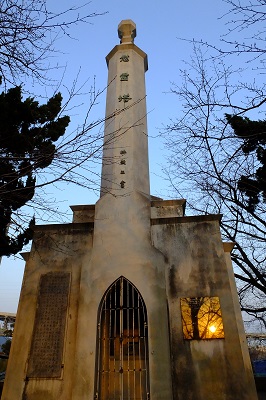
■分類:有形文化財(建造物)
■指定年月日:平成23年9月1日
昭和2年8月24日の夜、日本海軍連合艦隊による大演習が美保湾沖で行われた際、巡洋艦「神通」と駆逐艦「蕨」、巡洋艦「那珂」と駆逐艦「葦」が衝突し、「蕨」「葦」の乗組員計120名が犠牲となった。地元住民の協力によって懸命の捜索活動が行われたが、収容された遺体はわずかで、今も多くの兵士が海底に眠っている。この事故は、暗夜、無灯火で行われた激しい訓練が原因といわれ、当時、日本海軍史上最大の事故として世間の注目を集めた。
■指定年月日:平成23年9月1日
昭和2年8月24日の夜、日本海軍連合艦隊による大演習が美保湾沖で行われた際、巡洋艦「神通」と駆逐艦「蕨」、巡洋艦「那珂」と駆逐艦「葦」が衝突し、「蕨」「葦」の乗組員計120名が犠牲となった。地元住民の協力によって懸命の捜索活動が行われたが、収容された遺体はわずかで、今も多くの兵士が海底に眠っている。この事故は、暗夜、無灯火で行われた激しい訓練が原因といわれ、当時、日本海軍史上最大の事故として世間の注目を集めた。
事故の翌年、地元・花町の有志が中心となって忠魂碑(戦後に慰霊塔と改称)が建立された。塔はゴシック式を採用し、当時最新技術だった鉄筋コンクリート造で建てられた。頂上には殉職者の遺骨などを安置した納骨室が置かれ、内部には海軍から下付された砲身・機雷等が置かれた。塔の表面には、加藤寛治海軍大将の書による碑銘と、京都帝国大学教授三浦周行博士による碑文が刻まれたが、うち碑銘は、戦後、塔の名称変更に伴い、林敬三統合幕僚会議議長の書によるものに改められた。
事故から80年以上が経過し、当時を知る者も少なくなってきた。事故を後世に伝え、恒久平和を願うための象徴的な場所として、後世に残すべき財産である。
■公開状況:公開
■所在地:花町 台場公園内
■アクセス:JR境港駅下車、徒歩20分
■公開状況:公開
■所在地:花町 台場公園内
■アクセス:JR境港駅下車、徒歩20分
■ Classification: Tangible Cultural Property (Building)
■ Designated Date: September 1, 2011
When a large exercise by the Japanese Navy Combined Fleet was held off the coast of Miho Bay on the night of August 24, 1945. The cruiser "Jintsuu" collided with the destroyer "Culture", and the cruiser "Naka" collided with the destroyer "Ashi", killing a total of 120 crew members of "War" and "Ashi". Although a hard search was carried out with the cooperation of local residents, only a few bodies were contained and many soldiers are still sleeping on the seabed. It is said that this accident was caused by intense training conducted in the dark at night without lights, and at that time, it attracted public attention as the largest accident in the history of the Japanese Navy.
■ Designated Date: September 1, 2011
When a large exercise by the Japanese Navy Combined Fleet was held off the coast of Miho Bay on the night of August 24, 1945. The cruiser "Jintsuu" collided with the destroyer "Culture", and the cruiser "Naka" collided with the destroyer "Ashi", killing a total of 120 crew members of "War" and "Ashi". Although a hard search was carried out with the cooperation of local residents, only a few bodies were contained and many soldiers are still sleeping on the seabed. It is said that this accident was caused by intense training conducted in the dark at night without lights, and at that time, it attracted public attention as the largest accident in the history of the Japanese Navy.
The year after the accident, a monument to the loyalty (renamed to the memorial tower after the war) was erected mainly by volunteers from the local Hanamachi area. The tower adopted the Gothic style and was built with the latest technology at the time, reinforced concrete construction. At the top of the summit was a bone burial chamber where the remains of the line of duty death were placed, and inside was a barrel and mines subordinated by the Navy. On the surface of the tower, an inscription written by Admiral Kanji Kato and an inscription by Dr. Hiroyuki Miura, a professor of Kyoto Imperial University, were engraved. It was changed to the one written by the chairman.
More than 80 years have passed since the accident, and few people know the time. It is a property that should be left to posterity as a symbolic place to pass on the accident to posterity and wish for permanent peace.
More than 80 years have passed since the accident, and few people know the time. It is a property that should be left to posterity as a symbolic place to pass on the accident to posterity and wish for permanent peace.
■ Public status: Public
■ Location: In Hanamachi Daiba Park
■ Access: Get off at JR Sakaiminato Station, 20 minutes on foot
■ Location: In Hanamachi Daiba Park
■ Access: Get off at JR Sakaiminato Station, 20 minutes on foot
25)正福寺の地獄極楽図(Hell paradise map of Shofukuji)
■分類:民俗文化財(有形)
■指定年月日:平成23年9月1日
仏教では、死後は地獄・餓鬼・畜生・阿修羅・人間・天上の6つの世界(六道)を輪廻するとされているが、仏や菩薩への信仰によってこれらの世界から救われることを民衆に説くため、地獄・極楽などの様相を描いた絵図が各地で作られるようになった。
■指定年月日:平成23年9月1日
仏教では、死後は地獄・餓鬼・畜生・阿修羅・人間・天上の6つの世界(六道)を輪廻するとされているが、仏や菩薩への信仰によってこれらの世界から救われることを民衆に説くため、地獄・極楽などの様相を描いた絵図が各地で作られるようになった。
正福寺本堂にある「地獄極楽絵図(六道絵図)」もその1種で、地獄絵図3枚・極楽絵図1枚の計4枚で構成されている。うち地獄絵図3枚は1連の絵で、死者が地獄の王によって裁かれていく様子などが描かれており、極楽図には、宮殿や楼閣が聳え、金銀宝石で満ち溢れる理想郷・極楽浄土の様子が描かれている。
これらの絵図の製作年代・作者などに関する記録は残っていないが、専門家による分析の結果、18世紀頃、仏教絵画を専門とする絵師によって描かれたもので、明治期後半および平成12年の2度にわたって補筆されたことが分かっている。補筆によって、色彩など当初の姿が失われた部分もみられるが、当時の民衆信仰を伝える貴重な資料であることは間違いない。
■公開状況:公開(正福寺への事前連絡が必要)
■所在地:中野町 正福寺内
■アクセス:JR上道駅下車、徒歩10分
■公開状況:公開(正福寺への事前連絡が必要)
■所在地:中野町 正福寺内
■アクセス:JR上道駅下車、徒歩10分
■ Classification: Tangible cultural property (folk)
■ Designated date: September 1, 2011
In Buddhism, it is said that after death, the six worlds (six ways) of hell, hunger, brute, Ashura, humans, and heaven will revolve around. However, in order to preach to the people that they will be saved from these worlds by believing in Buddhism and Bodhisattva, pictures depicting aspects such as hell and paradise have begun to be made in various places.
The "Hell Paradise Picture (Rokudo Picture)" in the main hall of Shofukuji Temple is one of them, and consists of 3 hell pictures and 1 paradise picture, for a total of 4 pictures. Of these, three hell paintings are a series of paintings that show how the dead are being judged by the king of hell. The paradise map is an utopia full of gold and silver jewels, with palaces and towers towering. The state of Jodo is depicted.
There is no record of the production date and author of these drawings, but as a result of analysis by experts, they were drawn by a painter specializing in Buddhist painting around the 18th century, and were drawn in the latter half of the Meiji era and 2000. It is known that it was supplemented twice. There are some parts that lost their original appearance such as colors due to the supplementary writing, but there is no doubt that it is a valuable material that conveys the popular beliefs of the time.
■ Designated date: September 1, 2011
In Buddhism, it is said that after death, the six worlds (six ways) of hell, hunger, brute, Ashura, humans, and heaven will revolve around. However, in order to preach to the people that they will be saved from these worlds by believing in Buddhism and Bodhisattva, pictures depicting aspects such as hell and paradise have begun to be made in various places.
The "Hell Paradise Picture (Rokudo Picture)" in the main hall of Shofukuji Temple is one of them, and consists of 3 hell pictures and 1 paradise picture, for a total of 4 pictures. Of these, three hell paintings are a series of paintings that show how the dead are being judged by the king of hell. The paradise map is an utopia full of gold and silver jewels, with palaces and towers towering. The state of Jodo is depicted.
There is no record of the production date and author of these drawings, but as a result of analysis by experts, they were drawn by a painter specializing in Buddhist painting around the 18th century, and were drawn in the latter half of the Meiji era and 2000. It is known that it was supplemented twice. There are some parts that lost their original appearance such as colors due to the supplementary writing, but there is no doubt that it is a valuable material that conveys the popular beliefs of the time.
■ Public status: Public (advance contact to Shofukuji is required)
■ Location: Nakanocho Shofukuji
■ Access: Get off at JR Agarimichi Station, 10 minutes walk
■ Location: Nakanocho Shofukuji
■ Access: Get off at JR Agarimichi Station, 10 minutes walk
26)台場公園の黒松(Kuromatsu in Daiba Park)
■分類:天然記念物
■指定年月日:平成23年9月1日
市の木である黒松を後世に伝えていくため、市内に残る黒松の象徴として、台場公園内に残る黒松林が文化財として指定された。
■指定年月日:平成23年9月1日
市の木である黒松を後世に伝えていくため、市内に残る黒松の象徴として、台場公園内に残る黒松林が文化財として指定された。
(1)連理の松(1本)
文久年間(1861-63)、台場構築直後に植えられたもので、樹齢は140年以上と考えられている。二股に分かれた枝の一方が他方の幹に食い込んで差し渡しの橋ができていたため、大正の頃から「連理の松」として親しまれていた。しかし、成長によって枝の姿が変化し、現在では四股となって堂々とそびえ立っている。
台場を管理していた鳥取藩士・富山啓蔵によって植えられたと伝えられているが、この松の仲間は昭和57年に松くい虫被害のため7本伐採され、この「連理の松」が唯一の生き残りだといわれている。
(2)皇太子行啓時の記念植樹による松(10本)
南側土塁上、「連理の松」西側に10本並んで植えられている。明治40年、皇太子(後の大正天皇)が山陰行啓の際台場に立ち寄られたのを記念して植えられたもので、当初は今より本数も多かったが、松くい虫被害によって相当数が伐採されてしまった。樹齢102年。
(3)境港灯台と慰霊塔の間にある松(1本)
根元から約1mのところで二股に分かれている巨木で、幹の太さ、樹姿は(2)と類似していることから、明治28年、境港灯台が設けられた際に植樹されたうちの1本ではないかと考えられている。
■公開状況:公開
■所在地:花町 台場公園内
■アクセス:JR境港駅下車、徒歩20分
■公開状況:公開
■所在地:花町 台場公園内
■アクセス:JR境港駅下車、徒歩20分
■ Classification: Natural monument
■ Designated date: September 1, 2011
The black pine forest that remains in Daiba Park is a symbol of the black pine that remains in the city in order to pass on the black pine that is the tree of the city to posterity. It was designated as a cultural property.
(1) Renri no Matsu (1)
It was planted immediately after the construction of Odaiba during the Bunkyu era (1861-63), and is thought to be over 140 years old. Since one of the bifurcated branches cut into the trunk of the other to form a bridge, it has been popular as "Renri no Matsu" since the Taisho era. However, the shape of the branch changed due to growth, and now it is quadruped and stands proudly.
It is said that it was planted by Keizo Toyama, a Tottori feudal lord who managed Daiba, but in 1982, seven pine trees were cut down due to damage from pine worms, and this "Renri no Matsu" is the only one. Is said to be the survivor of.
(2) Pine trees (10 pine trees) planted in commemoration of the Crown Prince's dedication
Ten trees are planted side by side on the south side of the earthworks and on the west side of "Renri no Matsu". It was planted in commemoration of the Crown Prince (later Emperor Taisho) visiting Odaiba during the Sanin Yukihito in 1890. Initially, the number was larger than it is now, but a considerable number due to pine worm damage. Has been cut down . 102 years old.
(3) A pine tree between Sakaiminato Lighthouse and the memorial tower
It is a giant tree that is bifurcated about 1 m from the root, and because the thickness of the trunk and the appearance of the tree are similar to (2), it was planted when the Sakaiminato Lighthouse was established in 1887. It is thought that it is one.
■ Designated date: September 1, 2011
The black pine forest that remains in Daiba Park is a symbol of the black pine that remains in the city in order to pass on the black pine that is the tree of the city to posterity. It was designated as a cultural property.
(1) Renri no Matsu (1)
It was planted immediately after the construction of Odaiba during the Bunkyu era (1861-63), and is thought to be over 140 years old. Since one of the bifurcated branches cut into the trunk of the other to form a bridge, it has been popular as "Renri no Matsu" since the Taisho era. However, the shape of the branch changed due to growth, and now it is quadruped and stands proudly.
It is said that it was planted by Keizo Toyama, a Tottori feudal lord who managed Daiba, but in 1982, seven pine trees were cut down due to damage from pine worms, and this "Renri no Matsu" is the only one. Is said to be the survivor of.
(2) Pine trees (10 pine trees) planted in commemoration of the Crown Prince's dedication
Ten trees are planted side by side on the south side of the earthworks and on the west side of "Renri no Matsu". It was planted in commemoration of the Crown Prince (later Emperor Taisho) visiting Odaiba during the Sanin Yukihito in 1890. Initially, the number was larger than it is now, but a considerable number due to pine worm damage. Has been cut down . 102 years old.
(3) A pine tree between Sakaiminato Lighthouse and the memorial tower
It is a giant tree that is bifurcated about 1 m from the root, and because the thickness of the trunk and the appearance of the tree are similar to (2), it was planted when the Sakaiminato Lighthouse was established in 1887. It is thought that it is one.
■ Public status: Public
■ Location: In Hanamachi Daiba Park
■ Access: Get off at JR Sakaiminato Station, 20 minutes on foot
■ Location: In Hanamachi Daiba Park
■ Access: Get off at JR Sakaiminato Station, 20 minutes on foot
27)皇の松伝承地(Ou no Matsu Pine lore)
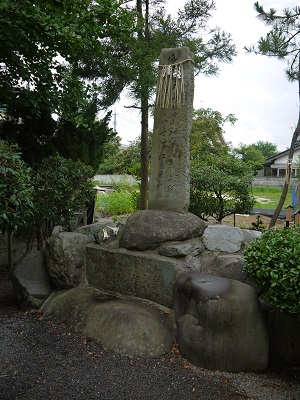
■分類:伝承地
■指定年月日:平成23年9月1日
承久3(1221)年7月、「承久の乱」の結果隠岐国に隠岐への配流が決まった後鳥羽上皇は、安来から船で隠岐へ向かい、途中7月27日に美保関に到着された。その道中、昼食を摂るため浜辺の大松の下に船を寄せられたが、その松の傍らには1軒のカヤ葺きの家があった。ここに住む老人が上皇に「そばもち」を献じたところ、上皇は「天が下おほふ袖だになきものを しばしはゆるせ浜松のかげ」と詠まれたと伝えられている。老人の家には、その時賜った小刀と、御湯を捧げた茶托が伝わっていたという。
■指定年月日:平成23年9月1日
承久3(1221)年7月、「承久の乱」の結果隠岐国に隠岐への配流が決まった後鳥羽上皇は、安来から船で隠岐へ向かい、途中7月27日に美保関に到着された。その道中、昼食を摂るため浜辺の大松の下に船を寄せられたが、その松の傍らには1軒のカヤ葺きの家があった。ここに住む老人が上皇に「そばもち」を献じたところ、上皇は「天が下おほふ袖だになきものを しばしはゆるせ浜松のかげ」と詠まれたと伝えられている。老人の家には、その時賜った小刀と、御湯を捧げた茶托が伝わっていたという。
この故事にちなみ、昭和5年、伝承ゆかりの地に上皇の御製を記した歌碑が建てられた。ゆかりの松は弓浜一の大木といわれ、「皇の松」と呼ばれて親しまれていたが、明治30年に枯死した。現在は4代目の松が植えられており、毎年8月、地元住民による「皇の松まつり」が松の下で行われている。地元住民による「皇の松保存会」は、祭のほか、「皇の松踊り」を考案し小学生に指導するなど、伝承を後世に伝えていくための活動に取り組んでいる。
松の周囲には、歌碑、小祠、皇の松会館(旧上道村役場)が建っているが、碑や小祠は伝承を伝える場所として、会館は児童クラブや伝承保存活動の拠点として地元住民に親しまれている。
■公開状況:公開
■所在地:上道町
■アクセス:JR上道駅下車、徒歩10分
■ Public status: Public
■ Location: Agarimichicho
■ Access: Get off at JR Agarimichi Station, 10 minutes walk
■公開状況:公開
■所在地:上道町
■アクセス:JR上道駅下車、徒歩10分
■ Classification: Tradition site
■ Designated date: September 1, 2011
■ Designated date: September 1, 2011
Emperor Go-Toba after the exile to Oki was decided in Oki Province as a result of the "Jokyu War" in July 1221. From Yasuki, I took a boat to Oki and arrived at Mihoseki on July 27th. Along the way, a boat was sent under a large pine tree on the beach for lunch, but there was a kaya-roofed house beside the pine tree. When an old man living here offered "soba mochi" to the emperor, it is said that the emperor was told that "the heavens are forgiving the things that are not on the sleeves of Hamamatsu for a while." It is said that the sword that was given at that time and the teacup that offered hot water were transmitted to the old man's house.
In connection with this event, in 1945, a monument was erected in a place related to folklore, which describes the work of the Emperor. The pine tree associated with it is said to be the largest tree in Yuhama, and was known as the "Ou no Matsu", but died in 1890. Currently, the 4th generation pine trees are planted, and every August, the "Ou no Matsu Festival" is held under the pine trees by local residents. In addition to the festival, the "Ou no Matsu Preservation Society" by local residents is engaged in activities to pass down the tradition to future generations, such as devising the "Dance of Ou no Matsu" and instructing elementary school students.
Around the pine, there are a monument, a small shrine, and the emperor's pine hall (formerly Agarimichimura government office). It has been popular.
In connection with this event, in 1945, a monument was erected in a place related to folklore, which describes the work of the Emperor. The pine tree associated with it is said to be the largest tree in Yuhama, and was known as the "Ou no Matsu", but died in 1890. Currently, the 4th generation pine trees are planted, and every August, the "Ou no Matsu Festival" is held under the pine trees by local residents. In addition to the festival, the "Ou no Matsu Preservation Society" by local residents is engaged in activities to pass down the tradition to future generations, such as devising the "Dance of Ou no Matsu" and instructing elementary school students.
Around the pine, there are a monument, a small shrine, and the emperor's pine hall (formerly Agarimichimura government office). It has been popular.
■ Public status: Public
■ Location: Agarimichicho
■ Access: Get off at JR Agarimichi Station, 10 minutes walk
28)境さんこ節(Sakai Sanko-bushi)
■分類:無形民俗文化財
■指定年月日:平成29年11月6日
境さんこ節は、唄、囃子、小太鼓、三味線、踊り(銭太鼓含む)から構成される。御廻米役所や鉄山融通会所など鳥取藩の役所が設立され、北前船の往来が繁盛を極めた頃、境港は商港としての地位を高めていった。その間、港湾の成長と共に歌い継がれてきたのが「境さんこ節」であり、その歌詞からは境港の移り変わりを伺い知ることができる。
北前船往来の繁盛は「さんこ節」を各地に広め、境さんこ節は安来節の元歌であるといわれている。また、同じく港町で歌い継がれた淀江さんこ節は、米子市の無形民俗文化財に指定されている。
■公開状況:―
■所在地:―
■アクセス方法:―
■classification:Intangible Folk Cultural Property
■Designated date:November 6, 2017
Sakai Sanko-bushi consists of songs, musical accompaniment, small drums, shamisen, and dances (including Zenidaiko). When Tottori clan government offices such as the Kaimai Yakusho and the Tetsuzan Yutsukaisho were established, and Kitamae-bune traffic flourished, Sakaiminato increased its status as a commercial port. During that time, the song “Sakaisanko-bushi” has been sung along with the growth of the port, and the lyrics tell us about the changes in Sakaiminato.
It is said that “Sanko-bushi” was spread throughout the country by Kitamae-bune orai merchants, and that Sakai-Sanko-bushi was the original song of Yasugi-bushi. Also, Yodoe Sankobushi, which has been sung in the port town for generations, is designated as an intangible folk cultural property of Yonago City.
■Public status:―
■Location:―
■Access method:―
■指定年月日:平成29年11月6日
境さんこ節は、唄、囃子、小太鼓、三味線、踊り(銭太鼓含む)から構成される。御廻米役所や鉄山融通会所など鳥取藩の役所が設立され、北前船の往来が繁盛を極めた頃、境港は商港としての地位を高めていった。その間、港湾の成長と共に歌い継がれてきたのが「境さんこ節」であり、その歌詞からは境港の移り変わりを伺い知ることができる。
北前船往来の繁盛は「さんこ節」を各地に広め、境さんこ節は安来節の元歌であるといわれている。また、同じく港町で歌い継がれた淀江さんこ節は、米子市の無形民俗文化財に指定されている。
■公開状況:―
■所在地:―
■アクセス方法:―
■classification:Intangible Folk Cultural Property
■Designated date:November 6, 2017
Sakai Sanko-bushi consists of songs, musical accompaniment, small drums, shamisen, and dances (including Zenidaiko). When Tottori clan government offices such as the Kaimai Yakusho and the Tetsuzan Yutsukaisho were established, and Kitamae-bune traffic flourished, Sakaiminato increased its status as a commercial port. During that time, the song “Sakaisanko-bushi” has been sung along with the growth of the port, and the lyrics tell us about the changes in Sakaiminato.
It is said that “Sanko-bushi” was spread throughout the country by Kitamae-bune orai merchants, and that Sakai-Sanko-bushi was the original song of Yasugi-bushi. Also, Yodoe Sankobushi, which has been sung in the port town for generations, is designated as an intangible folk cultural property of Yonago City.
■Public status:―
■Location:―
■Access method:―
問い合わせ先(Contact)
生涯学習課文化体育係(0859-47-1093)
Lifelong Learning Division Cultural and Physical Education Section (0859-47-1093)
Lifelong Learning Division Cultural and Physical Education Section (0859-47-1093)

